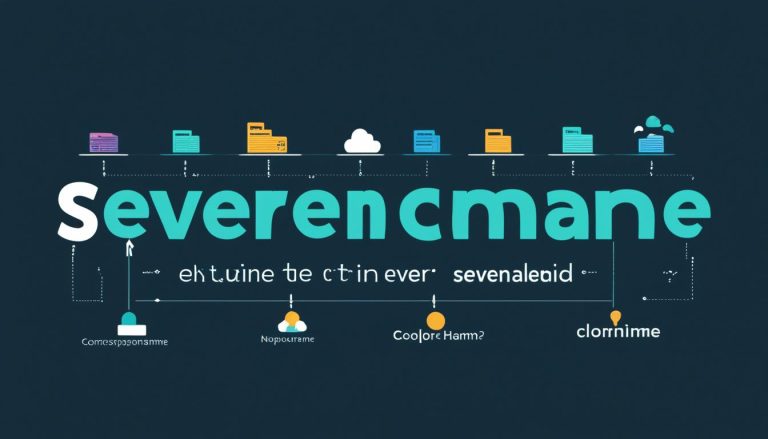Unpacking the Fundamentals: What is Source Code Explained
Source code is the foundation of computer programs, written by programmers to define the behavior and functionality of a software application. It encompasses a series of instructions, functions, definitions, and calls that work together to create a functioning program.
When it comes to source code, it is designed to be human-readable, allowing developers and other users to understand and modify it as needed. It can be created using various tools like text editors, visual programming tools, or integrated development environments.
Understanding source code is essential for anyone involved in software development, as it is the key to customizing software, enabling cross-platform development, and contributing to the software community at large. Proper source code management is crucial for collaboration and version control.
Key Takeaways:
- Source code is the foundation of computer programs, created by programmers.
- It consists of instructions, functions, definitions, and calls.
- Source code is human-readable and can be modified using various tools.
- Understanding source code is important for customization and collaboration.
- Proper source code management ensures effective software development.
What is Source Code?
Source code is the foundation of computer programs, written by programmers to define the behavior and instructions of a program. It includes functions, descriptions, definitions, calls, methods, and other operational statements. Source code is designed to be human-readable and understandable by developers and users. It can be created using text editors, visual programming tools, or integrated development environments (IDEs).
However, it’s important to note that source code does not apply to script languages like JavaScript, which are noncompiled or interpreted. Source code can be proprietary or open, depending on the licensing agreements. Proprietary software vendors like Microsoft restrict access to their source code to protect intellectual property, while open source software encourages collaboration and makes the source code available for public use.
Source code serves as the foundation for software creation, allowing customization, cross-platform development, and community contribution. It plays a crucial role in the development and enhancement of software, making proper management and understanding of source code essential for programmers and developers.
Example
“Source code is like a recipe for a dish. It contains all the ingredients, instructions, and steps needed to create a delicious meal. Just as a chef follows a recipe to cook a dish, programmers write source code to create software.”
Key Points
- Source code is the fundamental component of a computer program.
- It is written by programmers and consists of functions, descriptions, definitions, calls, methods, and other operational statements.
- Source code is human-readable and formatted for developers and users to understand.
- It can be proprietary or open, depending on the licensing agreements.
- Source code serves as the foundation for software creation, allowing customization, cross-platform development, and community contribution.
Now that we have a basic understanding of what source code is, let’s explore the importance of source code and its role in software development.
Importance of Source Code
Source code holds significant importance in the world of software development. It serves as the foundation for creating computer programs and allows programmers to write instructions that define the behavior of a program. The accessibility of source code empowers skilled users to customize software installations according to their specific needs. Additionally, access to source code enables developers to create similar programs for different operating platforms, facilitating cross-platform development. This promotes innovation and flexibility in the software industry, as programmers can leverage existing source code to build upon and improve their own applications.
Contributing to the source code community also plays a crucial role in the importance of source code. Programmers can learn from and recycle portions of existing code for other applications, fostering collaboration and knowledge sharing. Moreover, effective management of source code is essential for collaboration among developers and version control. By implementing proper source code management systems, programmers can prevent overwriting each other’s work and ensure seamless collaboration. Version control allows for tracking changes and reverting to previous versions if necessary, providing a streamlined workflow and enhancing overall productivity.
In summary, the importance of source code lies in its foundational role in software development and its ability to facilitate customization, cross-platform development, and community contribution. Proper management and understanding of source code are crucial for effective collaboration among developers and the enhancement of software applications.
Benefits of Source Code Management:
- Efficient collaboration among developers
- Version control to track changes and revert if necessary
- Prevention of overwriting each other’s work
- Enhanced productivity and streamlined workflow
Licensing of Source Code
The licensing of source code plays a crucial role in determining how it can be used, shared, and modified. Proprietary software vendors like Microsoft often choose to keep their source code closed and restrict access to it. This is done to protect their intellectual property and prevent unauthorized modifications that could potentially compromise the software’s functionality or security. Proprietary software licenses typically prohibit users from accessing or modifying the source code.
On the other hand, open source software takes a different approach by making the source code freely available to the public. This encourages collaboration and allows developers to study, modify, and distribute the source code. Open source software licenses, such as the GNU General Public License, provide the legal framework for this collaborative approach. Users of open source software have the freedom to use, modify, and distribute the source code, as long as they comply with the license terms.
| Proprietary Software | Open Source Software |
|---|---|
| Source code is closed and proprietary. | Source code is open and freely accessible. |
| Access to source code is restricted. | Source code can be studied, modified, and distributed. |
| Intellectual property is protected. | Collaboration and community-driven development. |
Proprietary software vendors like Microsoft often have strict licensing agreements to protect their source code.
On the other hand, open source software promotes transparency and allows for greater customization and collaboration. The choice between proprietary and open source software depends on the specific needs and objectives of the software development project.
When using proprietary software, developers and users are bound by the terms and conditions set by the software vendor. It is important to carefully review and understand the licensing agreements to ensure compliance and avoid any legal implications.
In summary, the licensing of source code determines how it can be used, shared, and modified. Proprietary software vendors restrict access to their source code to protect their intellectual property, while open source software promotes collaboration and allows for greater customization. Understanding the implications of different licensing models is essential for developers and users when choosing software for their projects.
Organization of Source Code
Proper organization of source code is crucial for efficient and effective software development. When writing source code, it is essential to structure it in a way that is logical and easy to navigate. By organizing source code into functions, classes, modules, and other logical structures, developers can easily understand and modify different parts of the codebase.
A well-organized source code makes it easier for multiple developers to collaborate on a project. Each developer can work on different parts of the codebase without interfering with each other’s work. It also allows for better code reuse, as well-structured code can be easily integrated into other projects or shared as libraries.
One common approach to organizing source code is to adopt a modular architecture. In this approach, the codebase is divided into modules, with each module focusing on a specific functionality or feature. This modular structure improves maintainability and allows for easier testing and debugging.
Another important aspect of organizing source code is following naming conventions and using meaningful variable and function names. This makes the code easier to understand and reduces confusion. Additionally, proper documentation, such as comments within the code, helps other developers understand the purpose and functionality of different code segments.
Table: Benefits of Organized Source Code
| Benefits | Description |
|---|---|
| Improved Collaboration | Organized source code allows multiple developers to work on different parts of a project without conflicts, enabling efficient collaboration. |
| Code Reusability | Well-structured code can be easily reused in other projects or shared as libraries, saving time and effort. |
| Maintainability | Organized code is easier to maintain, debug, and update, reducing the overall time and effort required for future modifications. |
| Enhanced Readability | Following proper naming conventions, using meaningful names, and including documentation improves code readability, making it easier for developers to understand and work with the codebase. |
Image source: https://seowriting.ai/32_6.png
History of Source Code
The history of source code can be traced back to the early days of computing when programmers wrote instructions in binary code. However, one of the earliest examples of source code as we recognize it today was written by Tom Kilburn, a pioneer in computer science, in 1948. During the 1950s and ’60s, as computer companies expanded software usage, the demand for source code grew. Computing magazines printed source code for readers to retype and use.
With the advent of floppy disks and the internet, source code became easier to share electronically. Over time, source code has evolved in complexity and sophistication, reflecting advancements in programming languages and software development practices. Today, source code serves as the foundation for software creation, customization, and cross-platform development.
“The history of source code is marked by the continuous innovation and collaboration of programmers worldwide. From its early days in binary code to the advancements of today, source code has played a crucial role in shaping the world of computing.”
Understanding the history of source code provides valuable insights into the foundations of modern programming and the evolution of software development practices. It showcases the iterative process of innovation and the community-driven nature of the programming world. As programmers continue to push the boundaries of technology, source code remains a critical component in driving progress and enabling new possibilities.

Key Milestones in the History of Source Code:
| Year | Development |
|---|---|
| 1948 | Tom Kilburn writes one of the earliest examples of source code |
| 1950s-60s | Computing magazines print source code for readers |
| 1970s | Introduction of high-level programming languages like C and Pascal |
| 1983 | Introduction of GNU Project and the Free Software Foundation |
| 1991 | Linus Torvalds releases the Linux kernel as open source |
| 2008 | Introduction of GitHub, a popular platform for sharing and collaborating on source code |
Understanding Source Code: A Deep Dive
In order to fully comprehend the intricacies of source code, it is essential for programmers to delve deeper into its inner workings. By gaining a deeper understanding of source code, developers can better grasp its limitations and extend its functionality to meet their specific needs.
One key aspect of understanding source code is recognizing its implementation using a Grammar Language. This language defines the syntax and structure of a program, allowing developers to write instructions and define the behavior of their code. The Grammar Language is used by the guidance library to parse the source code and create an Abstract Syntax Tree (AST). The AST represents the structure of the source code, facilitating easier manipulation and execution of the program.
When it comes to executing source code, programmers rely on a ProgramExecutor. This component attaches the executor to a program object and manages the flow of execution. The ProgramExecutor interacts with the AST, executing the source code statements and handling program control flow. Additionally, the guidance library includes specific commands, such as “gen” and “select,” which are defined in separate modules within the library’s directory. These commands provide additional functionality for the guidance programs.
Overall, understanding source code at a deeper level is essential for programmers looking to maximize their coding skills and leverage the full potential of their programs. By exploring the Grammar Language, Abstract Syntax Tree, ProgramExecutor, and library commands, developers can gain a comprehensive understanding of source code and enhance their capabilities as programmers.
Table: Key Concepts in Understanding Source Code
| Concept | Description |
|---|---|
| Grammar Language | Defines the syntax and structure of a program, allowing developers to write instructions and define behavior. |
| Abstract Syntax Tree (AST) | Represents the structure of the source code, facilitating easier manipulation and execution of the program. |
| ProgramExecutor | Attaches the executor to a program object and manages the flow of execution. |
| Library Commands | Additional functionality provided by the guidance library, such as “gen” and “select” commands. |
Guidance – A Template Language
Guidance is a template language that provides a top-level construct called a Program. A program defines the flow of a guided program that a Large Language Model (LLM) must follow. The syntax and structure of a guidance program are defined using a Grammar Language, which allows for parsing and execution.
The ProgramExecutor class in the guidance library is responsible for executing the guidance program by building an Abstract Syntax Tree (AST) from the source code. The Grammar Language implementation in the guidance library uses pyparsing, a parsing library, to define the grammar rules and extract meaningful information from the source code. The guidance library also includes a VariableStack class that represents the variables scope stack of the guidance program. This stack allows for the storage and manipulation of variables during program execution.
Guidance – Library Commands
The guidance library offers a range of powerful commands that enhance the functionality of guidance programs. These commands, such as gen and select, are implemented as separate modules within the _library directory of the guidance library. Let’s take a closer look at the key commands and their capabilities:
gen
The gen command enables text generation based on input and configuration. It utilizes the Large Language Model (LLM) to generate text by calling the llm_session method and providing the necessary parameters. With gen, programmers can dynamically generate text content to enhance the interactivity and personalization of guided programs.
select
The select command is a valuable tool for interacting with options in a guidance program. It allows users to select options from a given list based on the current program context. Behind the scenes, the select command leverages a Trie data structure to efficiently map and identify available options for selection. This functionality enhances the flexibility and adaptability of guided programs.
| Command | Description |
|---|---|
| gen | Enables text generation based on input and configuration using the Large Language Model (LLM). |
| select | Allows users to select options from a given list based on the current program context. |
The guidance library commands, including gen and select, provide valuable functionality to enhance the power and flexibility of guidance programs. By utilizing these commands, programmers can create dynamic and interactive guided experiences.
Conclusion
Source code serves as the foundation of computer programs, allowing programmers to write instructions and define program behavior. It is written in a human-readable format, making it understandable to developers and users. Source code can be created using text editors, visual programming tools, or integrated development environments (IDEs). Its importance lies in enabling software customization, cross-platform development, and community contribution.
Source code can be classified as proprietary or open, depending on licensing agreements. Proprietary software vendors like Microsoft restrict access to their source code to protect intellectual property, while open source software encourages collaboration by making the source code available under public licenses. Proper organization and management of source code are vital for effective collaboration and version control.
Understanding the history, importance, and structure of source code is essential for programmers. It allows them to enhance their skills, contribute to the software development community, and adapt to evolving programming practices. By mastering source code, programmers can create robust and efficient software that meets the needs of users in a rapidly evolving digital landscape.
FAQ
What is source code?
Source code is the fundamental component of a computer program. It is written by a programmer and consists of functions, descriptions, definitions, calls, methods, and other operational statements.
Why is source code important?
Source code serves as the foundation for software creation, allowing customization, cross-platform development, and community contribution. Access to source code enables programmers to understand its limitations and extend its functionality.
What is the difference between proprietary and open source software?
Proprietary software vendors like Microsoft restrict access to the source code of their software to protect intellectual property. Open source software, on the other hand, encourages collaboration and makes the source code available under public licenses.
How is source code organized?
Source code can be organized into functions, classes, modules, and other logical structures. These structures help developers in maintaining and enhancing the code.
What is the history of source code?
The first software was written in binary code in the 1940s. Source code as recognized today became more prolific in the 1950s and ’60s as computer companies expanded software usage. Over time, source code has evolved in complexity and sophistication.
How does the guidance language work?
The guidance language is a template language that provides a top-level construct called a Program. It allows programmers to define the flow of a guided program that a Large Language Model (LLM) must follow.
What are some library commands in the guidance language?
Some library commands in the guidance language include “gen” for text generation based on input and configuration, and “select” for selecting options from a given list based on the program context.
- About the Author
- Latest Posts
Claudia Rothenhorst ist Medien- und Reise-Redakteurin bei der Web-Redaktion. In ihrer Freizeit reist sie gerne und schreibt darüber unter anderem auf Reisemagazin.biz.
Weitere Artikel von Ihr erscheinen u.a. im Blog der Webagentur Awantego.






